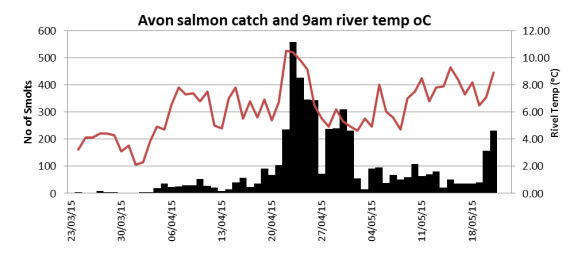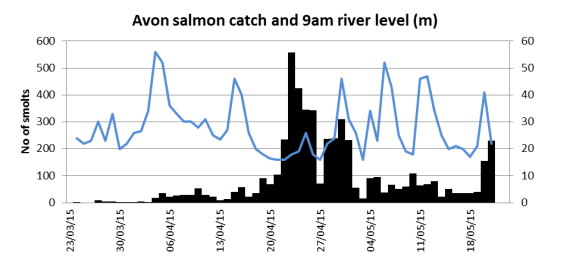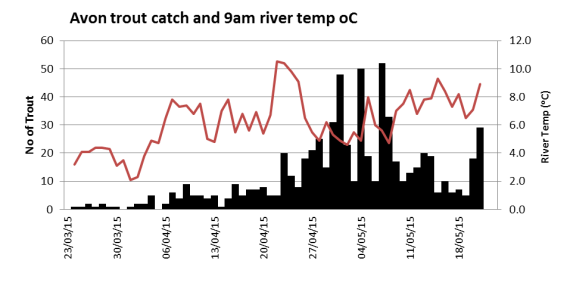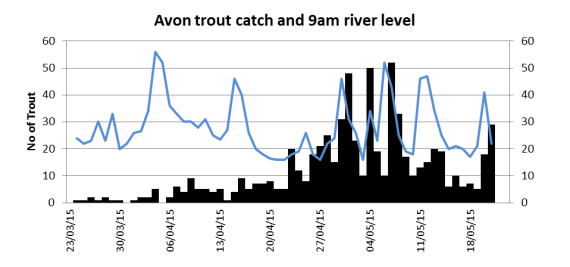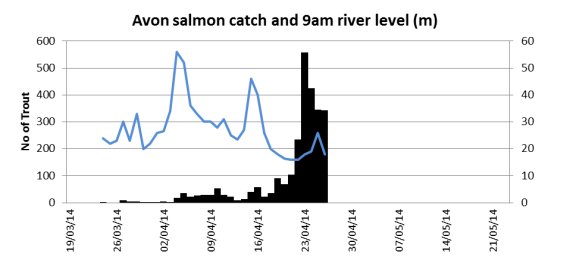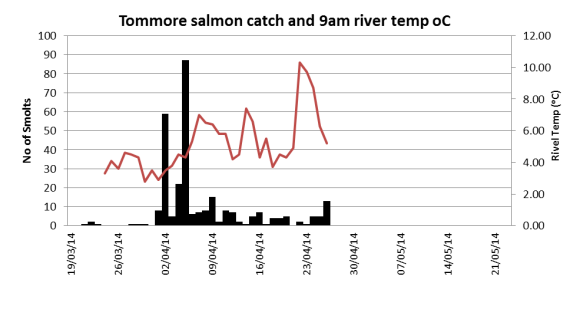The water butts on my greenhouse have been virtually full for the last month, due to frequent top-ups from heavy showers. Despite this the Spey, and tributaries, remain relatively low? Taking advantage of these good conditions for surveying we have cracked on with the electrofishing, mainly the timed salmon fry index surveys but also some quantitative surveys.
We have completed the repeat timed surveys of the Avon, and Livet, to assess the population after the very low counts last year in the Storm Frank aftermath. Today we also completed the salmon fry index surveys in the Fiddich and last night we hosted the annual ghillies outing to the two middle monitoring sites in the Burn of Tommore to assess the population of stocked salmon parr in that burn.
It has been a week of contrasts so far; on Tuesday we completed the upper Avon salmon fry index surveys where we usually find the sparsest salmon fry population and the smallest fry, and today we did the Fiddich where in 2014 we achieved out highest salmon fry counts.
The salmon fry index survey results for the Avon catchment are shown in the table below.
It was good to see that the salmon fry counts had recovered to a similar magnitude to those recorded in 2013. The overall pattern is the same with the highest counts in the lower reaches, declining with altitude. The contrast with the very low counts from last year are stark. Take the results from site TA15L1 for example, (this site is just above Greys Run towards the upper end of the Ballindalloch beats). Last year we could only catch 4.3 salmon fry per minute, or 13 during the three minute survey. This year, and in 2013, we managed to catch over 240 in three minutes.
The upper Avon counts are generally low, primarily in our view to low productivity. One interesting site, which was an anomaly in 2013 and in 2017 is site TA84L1, which is downstream of the Allt Loin Bheag. This tributary is only accessible to fish for a short distance and is therefore insignificant as a fish producer itself but it, along with other tributaries in the area, create a little pocket of productivity in an otherwise very low nutrient environment. In 2013 and 2017 the fry counts at this site were higher than those recorded in sites upstream and downstream. I also had a quick look at the mean size of fry from that site and found that they were 42mm compared to the low to mid 30mm for neighbouring sites.
A little green oasis. This tributary, which joins at the Avon at virtually 2000ft altitude is clearly more chemically rich than the Avon mainstem. In the vicinity of the confluence and for a short distance downstream the river bed supports mosses and, at this time of year, algae. This type of primary production must elevate the invertebrate population a little resulting in larger, and slightly more abundant fry.
The results from the Livet, one of the most productive of the Avon tributaries, were good with the fry counts four times higher than last year (Storm Frank affected).
Salmon fry index results from the Livet. 2016 was the first year that we did this type of survey in the Livet (except for a single survey in 2013) so there is not much of a baseline but the fry counts in 2017 were all in the good to excellent categories with one site in the super abundant category! The mean fry count in 2017 was more than four times higher than in last year.
Today we intended to have a relaxed day and I would have been happy to have made a good start on the Fiddich salmon fry index surveys. However, we were on a roll and in the end we completed all the monitoring sites in the Fiddich, with some pretty impressive results.
The mean fry count in 2017 was lower than in 2014 but the size and biomass of fry present in the sites downstream of Dufftown was incredible. As with the Livet all the Fiddich fry counts were in the good or excellent category with one coloured blue (reserved for counts greater than 100 per minute).
The record sheet for the site below the Balvenie warehouses is shown below (with one of the upper Avon sites for comparison).
Salmon fry index survey record sheet for the Fiddich at Balvenie and the Avon at Faindouran. Hopefully readers will be able to make out the figures. In the Fiddich site we caught 316 salmon fry (in three minutes), excellent but the most remarkable feature was the size of the fry. The largest was over 100mm (to be confirmed by scale reading) with all sizes from 50mm to over 95mm represented. A few large parr were also captured. The growth exhibited by the salmon fry in this Fiddich site means that many will potentially be large enough to smolt as one year olds; if they survive the winter. There were about 5 large fry per square metre of the river bed and with such a huge concentration of prey it was a wonder the place wasn’t infested with predators. Note the small size of the upper Avon fry in comparison, in fact all the Avon site parr, some of which could be three year old, were smaller than the largest of the Fiddich fry, which were only months old. Jim and I have a few years electrofishing experience between us and we agreed that what we witnessed today was unparalleled. There are reasons for this exceptional productivity of course: the temperature of the Fiddich is elevated by all the distillery discharges upstream and there may also be organic enrichment. Whether this is a good thing or not remains to be seen.
A jumbo salmon parr of 147mm from the Fiddich today.
Yesterday evening we completed the remaining two monitoring sites in the stocked Burn of Tommore. Readers will no doubt be aware of the Tommore project. The Tommore is inaccessible to migratory salmonids due to an impassable road culvert and has been stocked since 2012, From 2013 it has been stocked with fin-clipped 0+ salmon parr from the Sandbank Hatchery. The monitoring results from the remaining two sites last night were the best recorded there over the last four years with the salmon parr density at one of the sites reaching 34.5/100m2; high enough to make it into the excellent category in the SFCC Moray Firth Classification scheme.
The mean salmon parr density in the Tommore Burn was almost twice as high a recorded in previous years, with improved densities at all four sites. Explanations for this good result from the Tommore stocking were discussed last night. The trout parr density has remained relativity stable since 2013 but the number stocked in the burn in the autumn of 2016 had been reduced. Perhaps this is a case of less means more? Another factor could be that the number of smolts trapped in 2017, as they emigrated from the burn, was the lowest over the three years of trap operation so it is possible that a higher proportion had remained in the burn for an additional year . although the size distribution didn’t suggest that was the case.
Electrofishing survey sheet from site SA1b in the Burn of Tommore. 29 salmon parr were caught at this site. Note the absence of salmon fry due to the impassable culvert downstream.
The Burn of Tommore appears to be supporting a good population of stocked salmon parr this summer; based on that we would expect the number of smolts to higher next year, potentially significantly higher.
The post Spey electrofishing update appeared first on Spey Fishery Board.
Spey Fishery Board

